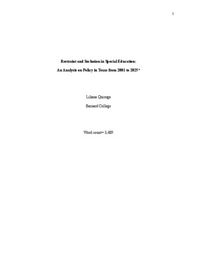Looking Beyond the Data: Centering Stories
Within my paper, I will not have an opportunity to explain my previous understandings and observations of restraint I have made. I would like to take this opportunity to discuss an important aspect of research: my personal connection. Human connection is greatly important to research, it allows for the observation of nuance and deeper understanding of emotional implications. This topic is something I have observed through my brother’s experience in special education. My experience growing up with a sibling with autism has inspired me to pursue work regarding disability rights.
Throughout my youth, I have watched my brother switch from countless public special education programs across my hometown. I have observed my brother being restrained in school multiple times. My brother is non-verbal, therefore my parents relied on the reporting and communication of educators and administrators in order to know if my brother had been restrained. No matter how policies or regulations exist regarding restraint or seclusion, there will always be situations in which restraint or seclusion is viewed as the only way to maintain safety.
Further, conversations about restraint and seclusion in special education often focus on data. It appears that we rely on the quantification of social phenomena in order to make it real. Understably, policymakers need numbers. Numbers are proof of an existing problem. However, stories are also proof. Stories provide insight into the struggles, emotional turmoil, and injustice that restraint and seclusion cause. Where data, numbers, and reporting fail, stories prevail. For these reasons, I have decided to use journalism and first-hand accounts of the misuse and underreporting of restraint and seclusion as opposed to solely relying on numbers provided by the Civil Rights Data Collection or the Texas Education Association. My goal is to understand how restraint and seclusion policy has changed in Texas by amplifying the voices of those affected by their use.

Please sign in
If you are a registered user on Laidlaw Scholars Network, please sign in
I love this message Liliana!
Thank you for sharing such a personal perspective. Lived experiences often reveal the nuance and emotional weight that numbers alone can’t capture. I truly admire how you’re using your research to amplify voices that are too often unheard.